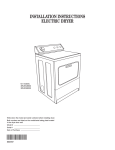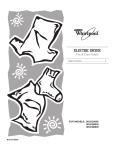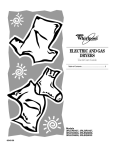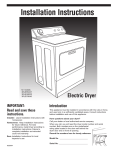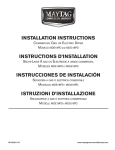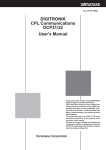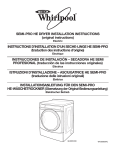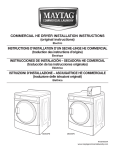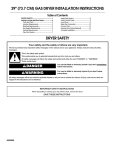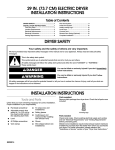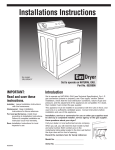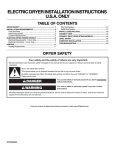Download Whirlpool 3RLEQ8033 Service manual
Transcript
INSTALLATION INSTRUCTIONS ELECTRIC DRYER for models: 3RLEC8600 3RLEQ8033 W10131579A Table of Contents DRYER SAFETY............................................................................ 2 INSTALLATION REQUIREMENTS .............................................. 2 Tools and Parts .......................................................................... 2 Location Requirements.............................................................. 3 Electrical Requirements ............................................................ 4 Venting Requirements .............................................................. 5 Plan Vent System ...................................................................... 5 INSTALLATION INSTRUCTIONS ............................................ 6 Install Vent System .................................................................... 6 Install Leveling Legs .................................................................. 6 Electrical Connection ................................................................ 7 Level the Dryer .......................................................................... 7 Connect Vent ............................................................................ 7 Complete Installation ................................................................ 7 DRYER SAFETY Your safety and the safety of others are very important. We have provided many important safety messages in this manual and on your appliance. Always read and obey all safety messages. This is the safety alert symbol. This symbol alerts you to potential hazards that can kill or hurt you and others. All safety messages will follow the safety alert symbol and either the word “DANGER” or “WARNING.” These words mean: You can be killed or seriously injured if you don't immediately follow instructions. DANGER You can be killed or seriously injured if you don't follow instructions. WARNING All safety messages will tell you what the potential hazard is, tell you how to reduce the chance of injury, and tell you what can happen if the instructions are not followed. IMPORTANT SAFETY INSTRUCTIONS When discarding or storing your old clothes dryer, remove the door. SAVE THESE INSTRUCTIONS INSTALLATION REQUIREMENTS Tools and Parts Gather the required tools and parts before starting installation. Read and follow the instructions provided with any tools listed here. Tools needed ■ ■ 2 level 20 to 30 cm (8" or l0") adjustable wrench that opens to 2,5 cm (1") ■ ■ ■ ■ ■ ■ ■ flat-blade screwdriver nut driver or socket wrench — 0,62 cm (1/4") caulking gun and compound knife duct tape hex-head socket wrench — 2,5 cm (1") tin snips Parts supplied Remove parts bag from dryer drum. Check that all parts were included. NOTE: No other fuel-burning appliance can be installed in the same closet as a dryer. Installation Clearances The location must be large enough to allow the dryer door to open fully. 4 leveling legs Recessed Area and Closet Installation Instructions Parts needed Check local codes, and read electrical and venting requirements before purchasing parts. Location Requirements This dryer may be installed in a recessed area or closet. For recessed area and closet installations, minimum clearances can be found on the serial tag on the dryer. The installation spacing is in centimeters (inches) and is the minimum allowable. Additional spacing should be considered for ease of installation, servicing, and compliance with local codes and ordinances. If closet door is installed, the minimum unobstructed air opening in the top and bottom is required. Louvered doors with equivalent air openings are acceptable. This dryer must not be installed behind a lockable door, a sliding door or a door with a hinge on the opposite side to that of the dryer. The dryer must be exhausted outdoors. No other fuel-burning appliance may be installed in the same closet as the dryer. Minimum Installation Clearances Observe all governing codes and ordinances. You will need ■ A location that allows for proper exhaust installation. The dryer must be exhausted to the outdoors. See “Venting Requirements.” ■ A sturdy floor to support the dryer and a total weight (dryer and load) of 79,4 kg (175 lb). The combined weight of a companion appliance should also be considered. ■ A level floor with a maximum slope of 2,5 cm (1") under entire dryer. If slope is greater than 2,5 cm (1"), install Extended Dryer Feet Kit, Part No. 279810. Clothes may not tumble properly and models with automatic sensor cycles may not operate correctly if dryer is not level. ■ It is important to make sure the room has an adequate air supply for drying operation. The operation of this appliance may affect the operation of other appliances which take their air supply for safe combustion from the same room. ■ Adequate ventilation must be provided to avoid a backflow of gases into the room from appliances burning other fuels, including open fires. If in doubt consult the appliance manufacturers. Do not operate your dryer at temperatures below 7ºC (45ºF). At lower temperatures, the dryer might not shut off at the end of an automatic cycle. The dryer must not be installed or stored in an area where it will be exposed to water and/or weather. Check code requirements. Some codes limit, or do not permit, installation of the dryer in garages, closets, mobile homes, or sleeping quarters. Contact your local building inspector. 35,6 cm (14") max. 45,7 cm (18") Closet door 10 cm (4") 2,5 cm (1") 2,5 cm (1") 68,6 cm (27") 2,5 cm (1") Closet side view Recessed front view Additional clearances for wall, door and floor moldings may be required or if external exhaust elbow is used. 7,6 cm (3") 310 cm2* (48"2) Front View closet door 155 cm2* (24"2) 7,6 cm (3") *Opening is the minimum for a closet door. Louvered doors with equivalent air openings are acceptable. 3 Electrical Requirements Product Dimensions Dimensions shown with feet extended 2,5 cm (1") from bottom of dryer. terminal block cover 27,9 cm (11") power supply cord/cable strain relief 35,6 cm (14") The dryer door extends 35,6 cm (14") from the front of the dryer when fully opened. 109,5 cm (43 ¹⁄₈") 97,2 cm (38 ¹⁄₄") This dryer is supplied without an electric cord and plug. It must be connected by a competent electrician to a single-phase electricity supply at the voltage shown on the dataplate, using a suitable fixed wiring installation in accordance with local and national wiring regulations. ■ A 3-wire circular cord of minimum conductor size 2.5 mm2 cross-section area should be used. ■ A 30A supply fuse should be used, and a switch with a minimum contact separation of 3 mm in both poles must be incorporated into the fixed wiring for dryer disconnection. The dryer should be positioned so that the disconnection switch is easily accessible to the user. ■ A cord clamp bush is provided on the dryer, and should be tightened on completion of wiring. The electrical mains terminals are located behind the small rear access panel (terminal block cover), and connections should be made in accordance with the terminal markings. Remember to replace the terminal access panel (terminal block cover). NOTE: In accordance with the European EMC Directive (89/336/EEC) the maximum electricity supply system impedance to which the electric dryer should be connected is declared to be 0.302 Ohm + j0.189 Ohm. 74,3 cm (29 ¹⁄₄") 68,6 cm (27") WARNING Side swing door clearances 57,8 cm (22 ³⁄₄") 9,8 cm (3 ⁷⁄₈") 48,9 cm (19 ¹⁄₈") Electric Shock Hazard Electric earthing is required on this dryer. 57,8 cm (22 ³⁄₄") Do not earth to a gas pipe. Do not have a fuse in the neutral or earthing circuit Location must be large enough to fully open dryer door. Check with a qualified electrician to be sure the dryer is properly earthed. Exhaust dimensions Failure to follow these instructions could result in death, fire, or serious injury. 10 cm (4") 35,9 cm (14¹⁄₈") back exhaust 4 10,8 cm (4¹⁄₄") 26 cm (10 ¹⁄₄") left or right side exhaust If codes permit and an additional earth bond wire is used, it is recommended that a competent electrician determine that the earth bond path is adequate. Recommended Earthing Method ■ It is your responsibility to contact a qualified electrical installer to ensure that the electrical installation is adequate and in conformance with all local codes and ordinances. Improper venting can cause moisture and lint to collect indoors, which may result in: ■ Moisture damage to woodwork, furniture, paint, wallpaper, carpets, etc. ■ Housecleaning problems and health problems. EARTHING INSTRUCTIONS SAVE THESE INSTRUCTIONS IMPORTANT: Observe all governing codes and ordinances. Use a heavy metal vent. Do not use plastic or metal foil vent. Rigid metal vent is recommended to prevent crushing and kinking. Flexible metal vent must be fully extended and supported when the dryer is in its final position. Remove excess flexible metal vent to avoid sagging and kinking that may result in reduced airflow and poor performance. An exhaust hood should cap the vent to prevent rodents and insects from entering the home. Exhaust hood must be at least 30,5 cm (12") from the ground or any object that may be in the path of the exhaust (such as flowers, rocks or bushes, etc.). If using an existing vent system, clean lint from the entire length of the system and make sure exhaust hood is not plugged with lint. Replace any plastic or metal foil vent with rigid metal or flexible metal vent. Venting Requirements Plan Vent System Route the Vent The exhaust outlet is located at the center of the rear of the dryer. The exhaust vent can be routed up, down, left, right or straight out the back of the dryer. A WARNING: To reduce the risk of fire, this dryer MUST BE EXHAUSTED OUTDOORS. ■ The dryer exhaust must not be connected into any gas vent, chimney, wall, ceiling, or concealed space of a building. ■ Do not use an exhaust hood with a magnetic latch. ■ Do not install flexible non-metal vent. ■ Do not install metal vent that is smaller than 10 cm (4") in diameter. ■ Do not install flexible vent in enclosed walls, ceilings or floors. ■ 10 cm (4") heavy metal vent and clamps must be used. ■ Use 10 cm (4") clamps to seal all joints. Vent must not be connected or secured with screws or other fastening devices which extend into the interior of the vent. Do not use duct tape. B C A. Standard rear offset exhaust installation B. Left or right side exhaust installation C. Bottom exhaust installation The design of the flue system should ensure that any condensate formed when operating the appliance from cold, is either retained and subsequently evaporated or discharged. Following these installation instructions should adequately meet this requirement. 5 Vent System Length 1. Select the route that will provide the straightest and most direct path outdoors. Plan the installation to use the fewest number of elbows and turns. Avoid making 90° turns. When using elbows or making turns, allow as much room as possible. Bend vent gradually to avoid kinking. A Exhaust Air Flow A. Better B. Good B 2. Determine vent length. The maximum length of the exhaust system depends upon: ■ The type of vent (rigid metal or flexible metal). ■ The number of elbows used. ■ Type of hood. Recommended hood styles are shown here. 10 cm (4") Number of Type of vent 90º turns or elbows Box or louvered hoods Angled hoods 0 Rigid metal Flexible metal 15,8 m (52 ft.) 9,4 m (31 ft.) 13,4 m (44 ft.) 7,0 m (23 ft.) 1 Rigid metal Flexible metal 13,4 m (44 ft.) 7,9 m (26 ft.) 11,0 m (36 ft.) 5,5 m (18 ft.) 2 Rigid metal Flexible metal 11,0 m (36 ft.) 6,7 m (22 ft.) 18,5 m (28 ft.) 4,3 m (14 ft.) 3 Rigid metal Flexible metal 8,2 m (27 ft.) 6,1 m (20 ft.) 6,4 m (21 ft.) 3,7 m (12 ft.) 4 Rigid metal Flexible metal 6,1 m (20 ft.) 5,5 m (18 ft.) 4,3 m (14 ft.) 3,0 m (10 ft.) Angled hood style acceptable. B A 3. Determine the number of elbows needed. NOTE: Do not use vent runs longer than specified in the Vent Length Chart. The following chart helps you determine your maximum vent length based on the number of 90° turns or elbows you will need and the type of vent (rigid or flexible metal) and hood that you will use. Vent Length Chart 10 cm (4") 6,4 cm (2¹₂") 10 cm (4") A. Box hood style B. Louvered hood style See the exhaust vent length chart that matches your hood type for the maximum vent lengths you can use. Exhaust systems longer than specified will: ■ Accumulate lint, creating a potential fire hazard. ■ Shorten the life of the dryer. ■ Reduce performance, resulting in longer drying times and increased energy usage. NOTE: Side and bottom exhaust installations have a 90º turn inside the dryer. To determine maximum exhaust length, add one 90º turn to the chart. The maximum length using a 5,1 cm x 15,2 cm (2" x 6") rectangular vent with 2 elbows and a 6,4 cm (2-1/2") exhaust hood is 2,4 m (8 ft.). For exhaust systems not covered by exhaust vent length charts (such as multiple unit hookups, plenums, and power-assist fans), see Service Manual, Part No. 603197. (To purchase the Service Manual, contact your local authorised service company). INSTALLATION INSTRUCTIONS Install Vent System 1. Install exhaust hood. Use caulking compound to seal exterior wall opening around exhaust hood. 2. Connect vent to exhaust hood. Vent must fit inside exhaust hood. Secure vent to exhaust hood with 10 cm (4") clamp. 3. Run vent to dryer location. Use the straightest path possible. See “Vent System Length.” Avoid 90º turns. Use 10 cm (4") clamps to seal all joints. Do not use duct tape, screws or other fastening devices that extend into the interior of the vent to secure vent. Install Leveling Legs 1. Open dryer door and remove drying rack, if included. Wipe drum with damp cloth to remove any dust. 2. Take two cardboard corners from dryer carton and place them on floor in back of dryer. Firmly grasp body of dryer and gently lay it on its back on the cardboard corners. 6 3. Start to screw legs into holes by hand. Use an adjustable wrench or 2,5 cm (1") hex-head socket wrench to finish turning legs until you reach the ridge with the diamond marking. Connect Vent 1. Connect vent to dryer outlet using 10 cm (4") clamp. If connecting to existing vent, make sure the vent is clean. The vent must fit over the dryer outlet and inside the exhaust hood. 2. Move dryer into final position. Do not crush or kink exhaust vent. Make sure dryer is level. A Complete Installation A. diamond marking 4. To protect the floor, use a large flat piece of cardboard from the dryer carton. Stand dryer up on the cardboard. Electrical Connection WARNING Electric Shock Hazard This dryer must be earthed. Securely tighten all electrical connections. Failure to do so can result in death, fire, or electric shock. 1. Check to be sure all parts are now installed. If there is an extra part, go back through the steps to see which step was skipped. 2. Check to be sure you have all of your tools. 3. Properly dispose of all packaging materials. 4. Check the dryer’s final location. Be sure the vent is not crushed or kinked. 5. Check to be sure the dryer is level. See “Level the Dryer.” 6. Read the Use & Care Guide to fully understand your new dryer. 7. Select a full heat cycle (not the air cycle) and start dryer. After five minutes, open dryer door. You should feel heat inside the dryer or on the exhaust vent. If dryer makes an unusual noise, check that dryer is level. Technical Specifications (see rating plate in door opening for full model details) 220-240V ~ 50 Hz, 1 ph 4575W, IPX4 Clothes capacity: 9.0 Kg max. This is a 3-wire dryer which must be earthed. This dryer is supplied without an electric cord and plug, it must be connected by a competent electrician. See “Electrical Requirements.” Level the Dryer 1. Move dryer close to its permanent location. Leave enough room to connect the exhaust vent. Remove the cardboard from under the dryer. 2. Check levelness of dryer by placing a level on top of dryer, first side to side, then front to back. If dryer is not level, use a wrench to adjust dryer legs up or down and check again for levelness. If legs are not long enough to level dryer, order Extended Dryer Feet Kit, Part No. 279810 (sold two legs per kit), from your dealer. The dryer must be level to reduce noise and assure proper performance. 7 W10131579A © 2007, Whirlpool Corporation 10/2007 Printed in U.S.A.








